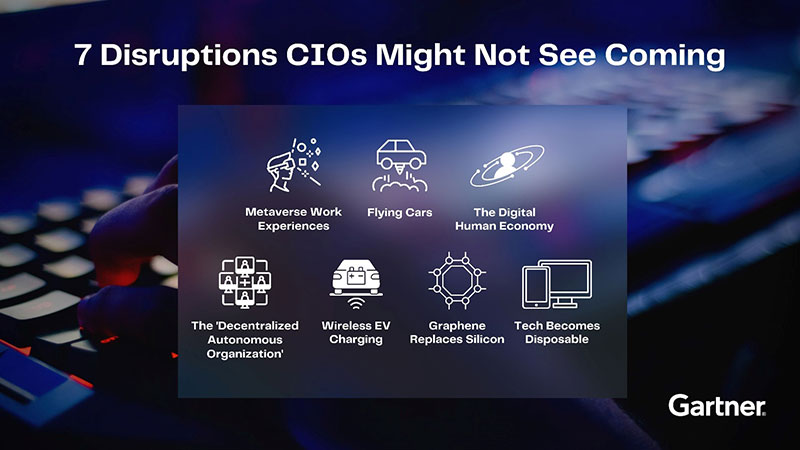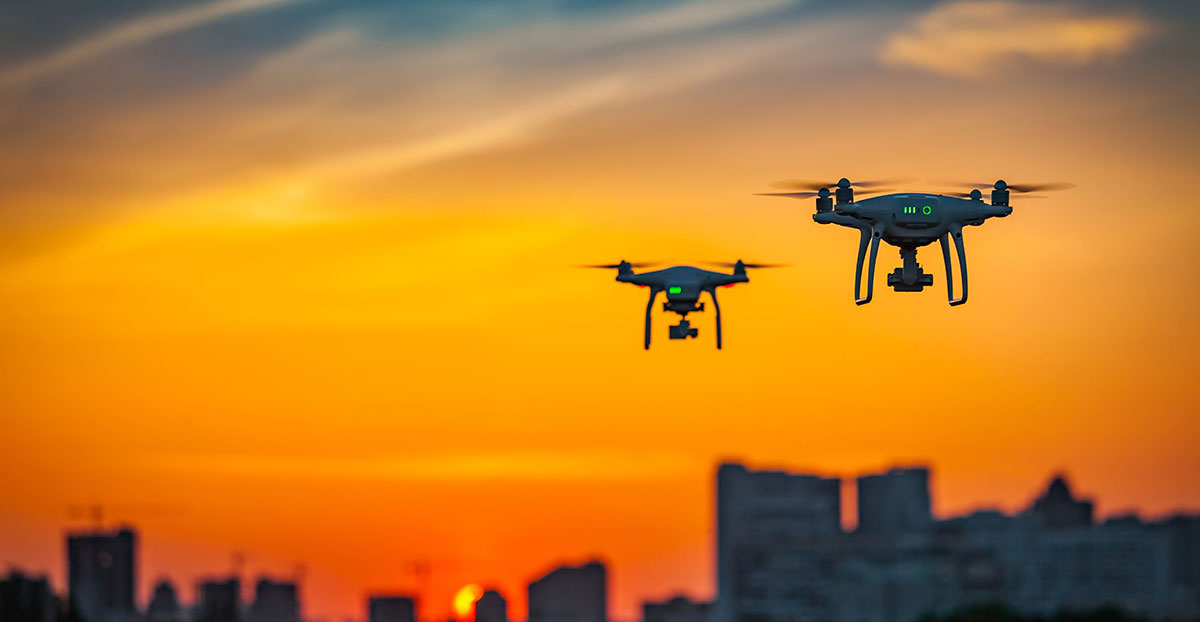มีหลายเหตุการณ์ที่เปลี่ยนโลกไปอย่างสิ้นเชิง และดูเหมือนว่าโลกอนาคตอาจอยู่ใกล้ตัวเรามากกว่าที่คิด

โดย เดวิด ยอคเคลสัน รองประธานฝ่ายวิจัย การ์ทเนอร์
ซีไอโอต้องใช้เวลาเพื่อพิจารณาถึงสถานการณ์ “จะเกิดอะไรขึ้นถ้า… (หรือ What If)” เพื่อไม่ให้เป็นการปิดหูปิดตาตัวเองจากกระแสดิสรัปชั่นทางสังคม พฤติกรรม และเทคโนโลยี ที่มีผลต่อการเติบโตขององค์กร
“การดิสรัปชั่นเป็นพื้นฐานของการเปลี่ยนแปลงที่ส่งผลต่อเนื่องอย่างถาวร และองค์กรที่ประสบความสำเร็จคือองค์กรที่พร้อมรับมือกับมัน โดยเราต้องตั้งคำถาม “จะเกิดอะไรขึ้นถ้า…” ต่อไปเรื่อย ๆ เพื่อเปิดรับโอกาสที่มาพร้อมกับการดิสรัปชั่น”
การเปลี่ยนแปลงครั้งใหญ่ 7 อย่างที่ผู้บริหารด้านเทคโนโลยีทั้งหลายควรใส่ใจพิจารณาในอีก 5 ปีข้างหน้านี้ ได้แก่

- ประสบการณ์การทำงานกับMetaverse
ในปัจจุบัน มีองค์กรมากมายใช้ประโยชน์จากเทคโนโลยี Metaverse ไม่ว่าจะเป็นการสร้างการมีส่วนร่วม การทำงานร่วมกัน และการเชื่อมต่อที่ดีขึ้นกับพนักงานในสถานที่ทำงานที่มอบประสบการณ์สมจริงยิ่งขึ้นในสำนักงานเสมือน และการใช้ประสบการณ์ Metaverse ภายในองค์กรหรือที่เรียกว่า Intraverses
การ์ทเนอร์ คาดการณ์ว่าการสร้างพื้นที่ทำงานเสมือนจริงเต็มรูปแบบ (Fully Virtual Workspaces) จะคิดเป็น 30% ของการเติบโตด้านการลงทุนในเทคโนโลยี Metaverse และจะพลิกโฉมประสบการณ์การทำงานในสำนักงานไปจนถึงปี 2570
- รถบินได้(Flying cars)
ยานยนต์ไร้คนขับหรืออากาศยานไร้คนขับ (UAV) ที่ใช้รับส่งผู้โดยสารเป็นระยะทางสั้น ๆ ตามเขตเมือง โดยอากาศยานที่บินได้ประเภทนี้หรือที่บางครั้งเรียกว่า “รถบินได้” หรือโดรนสำหรับผู้โดยสาร ถูกออกแบบให้ทำงานโดยไม่มีนักบินที่เป็นมนุษย์ บริษัทหลายแห่งกำลังทำงานเกี่ยวกับเครื่องบินรุ่นใหม่ที่ขับเคลื่อนด้วยปัญญาประดิษฐ์ (AI) และเพื่อสร้างวิถีการเดินทางทางอากาศที่เร็วกว่า ถูกกว่า ปลอดภัยกว่า และลดการปล่อยคาร์บอน โดยเฉพาะอย่างยิ่งในพื้นที่แออัด ซึ่งบริการแท็กซี่บินได้แห่งแรกมีกำหนดเปิดตัวในปี 2567
แม้จะมีความท้าทายด้านกฎระเบียบที่อาจเกิดขึ้น แต่ผู้บริหารไอทีควรพิจารณาและประเมินเกี่ยวกับปัญหาในด้านการขนส่ง การเคลื่อนย้ายคนและสินค้าขององค์กร ซึ่งอาจแก้ไขได้โดยใช้ยานพาหนะเหล่านี้แทน
- ระบบเศรษฐกิจของมนุษย์ดิจิทัล
ตั้งแต่การดูแลทางการแพทย์ การให้บริการลูกค้า เวอร์ชวลอินฟลูเอนเซอร์ (Virtual Influencer) และการฝึกอบรมของฝ่ายบุคคล ไปจนถึงการกู้คืนชีวิตผู้ตาย ล้วนเป็นความเป็นไปได้ของการใช้งานมนุษย์ดิจิทัลที่ไม่สิ้นสุด โดยระบบเศรษฐกิจมนุษย์ดิจิทัลนั้นนำเสนอโอกาสให้แก่ระบบนิเวศดิจิทัลใหม่ ๆ ซึ่งอาศัยศักยภาพของเทคโนโลยีที่นำบุคคลและองค์กรมารวมตัวกันเพื่อสร้างสรรค์และโต้ตอบในรูปแบบใหม่
การ์ทเนอร์คาดการณ์ว่าภายในปี 2578 ระบบเศรษฐกิจมนุษย์ดิจิทัล (The Digital Human Economy) จะมีมูลค่าตลาดสูงถึง 125 พันล้านดอลลาร์สหรัฐฯ และจะเติบโตอย่างต่อเนื่อง
- “องค์กรอิสระแบบกระจายอำนาจ” (The “Decentralized Autonomous Organization”)
องค์กรอิสระแบบกระจายอำนาจ (Decentralized Autonomous Organizations หรือ DAO) เป็นองค์กรรูปแบบใหม่ที่เกิดขึ้นในตลาดบริการด้านไอที การ์ทเนอร์ได้ให้คำจำกัดความ DAO ว่าเป็นหน่วยงานดิจิทัลที่ดำเนินงานบนบล็อกเชน และยังมีส่วนร่วมในการโต้ตอบทางธุรกิจกับองค์กร DAO อื่น ๆ หรือตัวแทนดิจิทัลและตัวแทนที่เป็นมนุษย์ โดยไม่ต้องมีการบริหารจัดการบุคลากรในแบบเดิม ๆ
พนักงานที่มีความรู้ความสามารถด้านดิจิทัลระดับสูงจำนวนมากจะถูกดึงดูดให้ทำงานในองค์กร DAO แม้ตอนนี้จะยังอยู่ในช่วงเริ่มต้น แต่ DAOs มีศักยภาพที่จะก่อให้เกิดการเปลี่ยนแปลงอย่างมากต่อบรรทัดฐานของอุตสาหกรรมเทคโนโลยีหลายประการที่เป็นอยู่ ณ ปัจจุบัน
- การชาร์จรถยนต์ไฟฟ้า(EV) แบบไร้สาย
เมื่อการชาร์จแบบไร้สายพร้อมให้บริการแล้ว จะเป็นแนวทางที่เหมาะสมที่สุดสำหรับยานพาหนะในกลุ่มรถประจำทางและรถแท็กซี่ ซึ่งยานพาหนะเหล่านี้สามารถใช้การชาร์จแบบไดนามิก (Dynamic Charging) ได้อย่างมีประสิทธิภาพ ช่วยเพิ่มระยะทางขับขี่ได้ไกลขึ้นและลดต้นทุนต่าง ๆ
นอกจากนั้นการติดตั้งสถานีชาร์จไฟในที่พักอาศัยจะกลายเป็นตลาดที่ใหญ่ที่สุดสำหรับการชาร์จรถยนต์แบบไร้สาย เนื่องจากเจ้าของรถยนต์ไฟฟ้า (EV) จะสะดวกขึ้นโดยไม่ต้องเสียบสายเคเบิลให้ลำบาก อย่างไรก็ตาม เมื่อมองไปไกลกว่านั้น การ์ทเนอร์คาดว่าโครงการบ้านจัดสรรของภาคเอกชนและพื้นที่ว่างแบบแคมปัสของสถาบันการศึกษาจะมีปริมาณการติดตั้งสถานีชาร์จไร้สายแซงหน้าการติดตั้งที่บ้านพักอาศัย
6.กราฟีนจะมาแทนที่ซิลิกอน
ในอีก 7 ถึง 10 ปีข้างหน้านี้ เราจะเห็นศักยภาพมหาศาลของอุปกรณ์ทรานซิสเตอร์แบบฟิลด์เอฟเฟกต์ที่ใช้คาร์บอนเป็นโครงสร้างหลักทดแทนซิลิคอนในทรานซิสเตอร์แบบเดิมที่มาถึงขีดจำกัดเรื่องขนาดที่เล็กสุด ตัวอย่างหนึ่งคือ กราฟีน ซึ่งเป็นวัสดุคาร์บอนบริสุทธิ์ความหนาหนึ่งอะตอม เรียงต่อกันเป็นโครงสร้างแบบรังผึ้งหกเหลี่ยม ซึ่งกราฟีนสามารถแทนที่อุปกรณ์ซิลิกอนในปัจจุบันได้ โดยเฉพาะอย่างยิ่งใช้สำหรับการสื่อสารไร้สาย โดยที่อุปกรณ์ FET ที่ทำมาจากคาร์บอนเหล่านี้สามารถเก็บกระแสไฟฟ้าที่สูงกว่าได้มากในพื้นที่ขนาดเล็กลง ทำให้สามารถประมวลผลได้รวดเร็ว
ซีไอโอควรพิจารณาความเป็นไปได้ใหม่ ๆ ที่เกิดจากเทคโนโลยีที่ใช้ “กราฟีน” และเริ่มค้นหาซัพพลายเออร์ที่เกิดใหม่ สำหรับเตรียมพร้อมรับมือการเปลี่ยนแปลงที่จะเกิดขึ้น
- เทคโนโลยีกลายเป็นของใช้แล้วทิ้ง
จะเกิดอะไรขึ้นหากวงการเทคโนโลยีจะกลายเป็นแบบเดียวกับวงการแฟชั่น ด้วยการออกแบบแอปพลิเคชันที่ “ใช้แล้วทิ้ง” อย่างรวดเร็ว? ขณะที่องค์ประกอบต่าง ๆ ในการดำเนินธุรกิจที่เน้นความคล่องตัวเป็นหลัก (Business Composability) ได้รับการยอมรับในวงกว้าง ถือเป็นโอกาสของผู้บริหารไอทีที่จะดำเนินการไปอีกขึ้นและเตรียมพร้อมสร้างความยืดหยุ่นให้แก่เทคโนโลยีแบบที่ใช้แล้วทิ้ง
เรียนรู้เทคโนโลยีที่ขับเคลื่อนการทำธุรกิจดิจิทัลและนวัตกรรมต่าง ๆ ในปี 2565 ได้ที่ Gartner Top Strategic Technology Trends for 2022 e-book.
